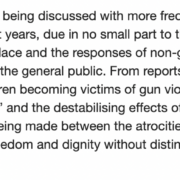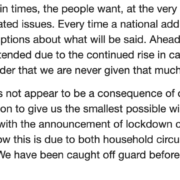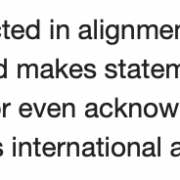Published in Culture Clash — a biweekly column in The Tribune — on May 3, 2017
With the general election one week away, the last debate organised by University of The Bahamas’ School of Social Sciences held last night and all plans of the three major parties published on their websites, it’s decision time.
We don’t hear much about the issues at rallies. They are celebratory in design and execution, bringing more music, one-liners and dancing than substantial plans for the next five years. Door-to-door visits are seldom made by the candidates themselves, leaving the questions of many constituents unanswered. Constituency offices are barely open until a few weeks before election, and rarely staffed by people with complete information, or even able to put constituents in immediate and direct contact with the candidate.
We have very little to go on as we approach the polls. I visited several constituency offices to request hard copies of their plans, but they all directed me to their websites. When I asked about options for people with limited internet access, I was met with no response.
While the plans are long, and not always organised or designed in the most intuitive ways, I found reading them side-by-side quite beneficial. I’ve chosen to focus on specific aspects of each of the three plans, and highlight some of their components to give a general idea of party promises.
PLP Charter 2017
The Progressive Liberal Party has identified, in Charter 2017, five key tools for development – environmental sustainability, good governance and civic responsibility, cultural development, youth empowerment, and technology. It’s action plan is divided into six areas of focus – expand opportunities, empower Bahamians, protect our citizens, care for our people, preserve what makes the Bahamas special, and strengthen citizen participation in governance. I find these titles quite odd, but the subheadings for each – not shown on the website but shown in the download – help to set expectations.
Charter 2017 can be viewed on six separate webpages or downloaded as an 84-page document. In each of its sections, Charter 2017 gives an overview of the PLP’s work since 2012. For example, Expand Opportunities boasts of over 40 per cent reduction in electricity costs (with no further explanation), the College of The Bahamas’ transition to University of The Bahamas, expected job creation through Baha Mar and expansion of the Royal Bahamas Defence Force fleet. It then lists plans for the next five years such as generation of new jobs through BAMSI, building a college-based city in North Andros, creating policies to ensure 75 to 80 per cent of tourism revenue remains in the Bahamas, implementing a revitalisation plan for downtown Nassau, and developing Exuma as an economic and transportation hub to bridge the northern and southern Bahamas.
The PLP’s Charter 2017 further promises the development of a Cultural and Creative Industries Sector yielding $200 per tourist ($1 billion of new revenue), alleviation of debt burden by capping interest, doubled investment in public school scholarships, creation of “Second Start” to help adults develop new skills, launch of a forensic laboratory, a biometric bail reporting process, development of Family Island health facilities to include new equipment and more doctors and nurses, and free electricity for those under (an unspecified) limit (expected to affect 15 to 20 per cent of low income households).
It also proposes the development of a Standing Forum for the Bahamian diaspora, inviting Bahamians to return annually, bringing their talent, skills and experience to work toward national development. Some components appear to be copied from the Vision 2040 National Development Plan (NDP) of the Bahamas such as Services Bahamas – one-window access to a range of government services. It, of course, also includes buzzwords like Freedom of Information Act and references to widely demanded systems like consultative processes with green papers and white papers and a paper-free public service.
Charter 2017 is relatively easy to read, laid out in bullet points with bold type for key phrases. The points do not include much details, but give a general idea of what the PLP intends to accomplish, why, and how.
FNM Manifesto
The Free National Movement (FNM) Manifesto is a much more basic plan with less detail, mostly stopping at the mention of an item. the manifesto is divided into 23 sections including immigration, healthcare, economy, good governance, education, judicial reform, tourism, and the environment. there does not seem to be a one-click option to download or even view the full plan. the website offers a history of the party and a biography of the party leader, but there is no framing of the manifesto.
In its social agenda, the FNM commits to the implementation of the Disability Equal Opportunity Act and lists a number of specific actions such as making parking in disabled parking spots an offence and establishing facilities so caregivers could have respite. It seeks to create a Ministry of Environment, inaugurate a National Clean-up Day, and phase out use of plastic bags by 2020. On crime, the FNM proposed a zero-tolerance approach, shares the PLP’s interest in a forensic lab and plans to “eliminate habitats where criminally flourish”.
Interestingly, the FNM has a section on public life which lists seven principles. They are selflessness, integrity, objectivity, accountability, openness, honesty, and leadership. Each item is explained, and would suggest FNM candidates make their public disclosures on time and are transparent about their decisions. In general, the plan is quite difficult to read, because it requires visits to 23 different pages, used colour backgrounds and has multiple nested lists. Unfortunately, with such simple line items, it does not feel like it is worth the work.
DNA Vision 2017 & Beyond
The Democratic National Alliance (DNA) has Vision 2017 & Beyond on its website, easy to view and download. The 62-page document begins with the vision and mission, message from the party leader and a list of 23 priorities for its first year should it win the election.
These include forming a Ministry of Natural Resources and Environment, launching Commissions of Inquiry on Baha Mar and Bank of The Bahamas, raising minimum wage to $250, establishing a national lottery and legislating for the reinforcement of capital punishment.
Vision 2017 & Beyond is divided into eight areas of focus – good governance, national security, business and the economy, youth, education and culture, energy and the environment, healthcare and social policy, and Grand Bahama and the Family Islands.
The DNA has the strongest response to the demands of Bahamians who want political and electoral reform. It states its commitment to establishing the Office of the Ombudsman, an anti-corruption act, revision and strengthening of the Public Disclosure Act and making the Attorney General an independent position. Vision 2017 & Beyond also speaks to electoral reform, listing campaign finance reform, fixed election dates, term limits, recall of MPs and moving to a proportional representation system.
Through its plan, the DNA commits itself to reducing electricity costs by 50 per cent, move toward having 40 per cent renewable power by 2027, formation of a National Procurement Agency to oversee tender processes, developing a unified bus system, reducing public debt to 65 per cent of Gross Domestic Product (GDP) by 2022, and reducing unemployment to eight per cent by 2021. It also makes mention of “one-stop portal” for the Business Licence Unit, which is akin to the one-window service in the NDP. The party also includes smaller projects that, no doubt, can be undertaken by its candidates whether they win or lose. These include the online “super library” and the fruit tree planting drive.
It’s interesting to consider the plan of the DNA and derive its value. The approach to crime is questionable, particularly when considering the impact of another maximum security prison, increased foot patrol and capital punishment. Punishment seems to get more focus than crime prevention, or addressing the issues that can lead to crime.
Comparing the three parties’ plans is not an easy task. They do not use the same style, and do not even focus on the same areas. Still, even a quick read gives a sense of values, priority areas, feasibility. The PLP Charter 2017 is the most detailed of the three, and likely benefitted from the NDP. The FNM Manifesto has simplicity, but lacks substance. The DNA has buzzwords and pet issues front and centre, but does not explain process. These plans will not give us all the answers, but in one week, we have to make a choice. It’s on us to be informed and prepared, and make our way to the polls on May 10 to make our marks.












Leave a Reply
Want to join the discussion?Feel free to contribute!